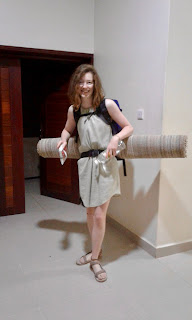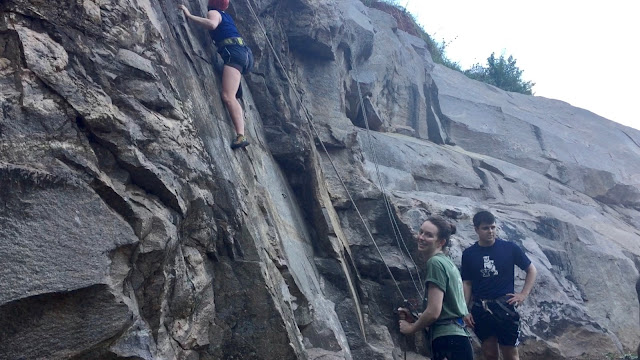Ugandans love to dress up, and they will wear their best clothing often, no matter the occasion. One day the young woman who sits next to me at work was in a long gown and the other day she was in a pink hoodie and plain knee-length black skirt. The most sexualized part of a woman’s body is her lower thigh just above the knee cap. For some older, more traditional men, they view it as pretty obscene. However, all skirts fall right at the knee—until you get on the university campus. Women pretty rarely wear pants; it’s funny when all three of the Yalie women show up at work in pants but all of our female coworkers are wearing skirts and dresses. Instead of wearing shorts to exercise (never!), women and girls here wear leggings, no matter how tight or see-through. This has struck me and my other American friends as so odd, because for us athletic shorts are the more conservative option. It’s been a little tough when we want to go running in the heat of the afternoon and have to wear restrictive pants or leggings.
Women’s breasts are not sexualized here as much as in the West, because every woman almost constantly has a baby, so breastfeeding in public is very regular. Tank tops and low-cut shirts are common for women. Clothing showing the midriff and back are not too unusual either. I think it may have to do with the longtime Indian immigrants and their saris. Older women and slightly more rural women will wear traditional dresses or long skirts made of printed cloth with colorful patterns. No one working at IDI will ever wear these dresses (except this one British woman who also wears hiking sandals with the dresses …) but many of the patients do. Every single woman in the villages by Lake Bunyonyi and in Luuka was wearing one. For the Buganda and Busoga ethnic groups, the dresses are called gomesi and they have pointy shoulders.
 |
| Picture from a Kampala newspaper of female cabinet ministers wearing gomesi |
There is an enormous difference between what Ugandan women wear during the day and what they wear at night. If they are going out for a nice dinner, or to a show, bar, or club, or hanging out with friends, they dress just like American women—super short skirts and dresses, anything goes! I’m not sure how this dichotomy is able to exist in a culture that pretends at very conservative.
The men in Uganda all tend to wear the same thing, that is pants and either a t-shirt, a polo, or a long-sleeve button down. Like Nicaragua, a lot of the t-shirts are brought here secondhand from the West, so they say the most random things. I went up to a young guy in a Yale sweatshirt but turns out he does not, in fact, go to Yale. (Looking in the Yale student facebook, there is only one Ugandan currently attending, and she’s from Kampala, but I do also know a Moses from orgo section whose family is from Kampala.)
 |
| The mosque near Makerere University |
Just under fifteen percent of Ugandans are Muslim, with many more in Kampala, so sometimes there’ll be men wearing a kufi or even a thobe. Only a handful of non-Muslim men might wear the traditional East African kanzu (a long robe, usually white, essentially the same as a thobe). The Muslim women wear hijab and sometimes long robes. It was very confusing for me at first because I saw all these women in headscarves who were eating during the day (even though it was Ramadan when Muslims fast sunup to sundown). However, many Ugandan women wear headscarves whenever they feel like it. It’s part of the traditional attire, and Black hair is much higher maintenance than White hair, of course.
Another thing I’ve learned is that Ugandans like to keep their babies toasty. I’ve seen babies in the sweltering clinic wrapped in so many blankets you can’t find the baby. I saw one baby in a snow suit! All the schoolchildren, girls or boys, have their heads shaved and wear uniforms. But then I see schoolchildren wearing winter coats on top, and then I see boda drivers wearing parka and mittens, and then I see every other person on the street wearing a winter cap, so I guess all Ugandans like to be toasty.
 The first stop on our two-day budget safari adventure last weekend was the Ziwa Rhino Sanctuary where we trekked endangered white rhinos on foot for a couple hours. Really the rhinos trekked us. Upon setting out, we immediately stumbled upon a group of 4 rhinos, which is really rare because they are solitary animals. They kept lumbering closer and closer to us as they grazed, so our ranger was constantly having us backpedal and swerve behind bushes. Rhinos are supposedly really dumb, and if they charge you're just supposed to stand behind a tree and they will soon forget about you. Next, we found a mother rhino and her baby, who was making whining calls. We watched as the huge mother lay down and let the baby breastfeed. The white rhinos had been extinct since 1983 in Uganda after civil wars. The sanctuary was started by rhinos brought from other countries. The first calf born in Uganda had a father from Kenya and a mother from Disney Animal Kingdom--so he was named Obama!
The first stop on our two-day budget safari adventure last weekend was the Ziwa Rhino Sanctuary where we trekked endangered white rhinos on foot for a couple hours. Really the rhinos trekked us. Upon setting out, we immediately stumbled upon a group of 4 rhinos, which is really rare because they are solitary animals. They kept lumbering closer and closer to us as they grazed, so our ranger was constantly having us backpedal and swerve behind bushes. Rhinos are supposedly really dumb, and if they charge you're just supposed to stand behind a tree and they will soon forget about you. Next, we found a mother rhino and her baby, who was making whining calls. We watched as the huge mother lay down and let the baby breastfeed. The white rhinos had been extinct since 1983 in Uganda after civil wars. The sanctuary was started by rhinos brought from other countries. The first calf born in Uganda had a father from Kenya and a mother from Disney Animal Kingdom--so he was named Obama! The majority of the weekend was spent several hours northwest of Kampala in Murchison Falls National Park, Uganda's largest national park at 1500 square miles bisected by the Nile. We saw the most powerful waterfall in the world and where we went on a six-hour game drive starting before dawn. We saw elephants, hyenas, baboons (so human-like), Patas monkeys, buffaloes, bushbucks, warthogs, a crocodile, thousands of kob (East African antelope), vultures, and an eagle all right next to the off-roading van (walking around in the park was prohibited). We also saw a leopard and some hippos in the distance. The best moment was finally spotting a couple giraffes, but then more and more raised their heads and we realized we were surrounded by about thirty. We stayed the night for $6 inside the park and got about that value. We did a lot of mosquito net patching with duct tape and ate the ramen we brought to avoid buying expensive park food.
The majority of the weekend was spent several hours northwest of Kampala in Murchison Falls National Park, Uganda's largest national park at 1500 square miles bisected by the Nile. We saw the most powerful waterfall in the world and where we went on a six-hour game drive starting before dawn. We saw elephants, hyenas, baboons (so human-like), Patas monkeys, buffaloes, bushbucks, warthogs, a crocodile, thousands of kob (East African antelope), vultures, and an eagle all right next to the off-roading van (walking around in the park was prohibited). We also saw a leopard and some hippos in the distance. The best moment was finally spotting a couple giraffes, but then more and more raised their heads and we realized we were surrounded by about thirty. We stayed the night for $6 inside the park and got about that value. We did a lot of mosquito net patching with duct tape and ate the ramen we brought to avoid buying expensive park food.
































